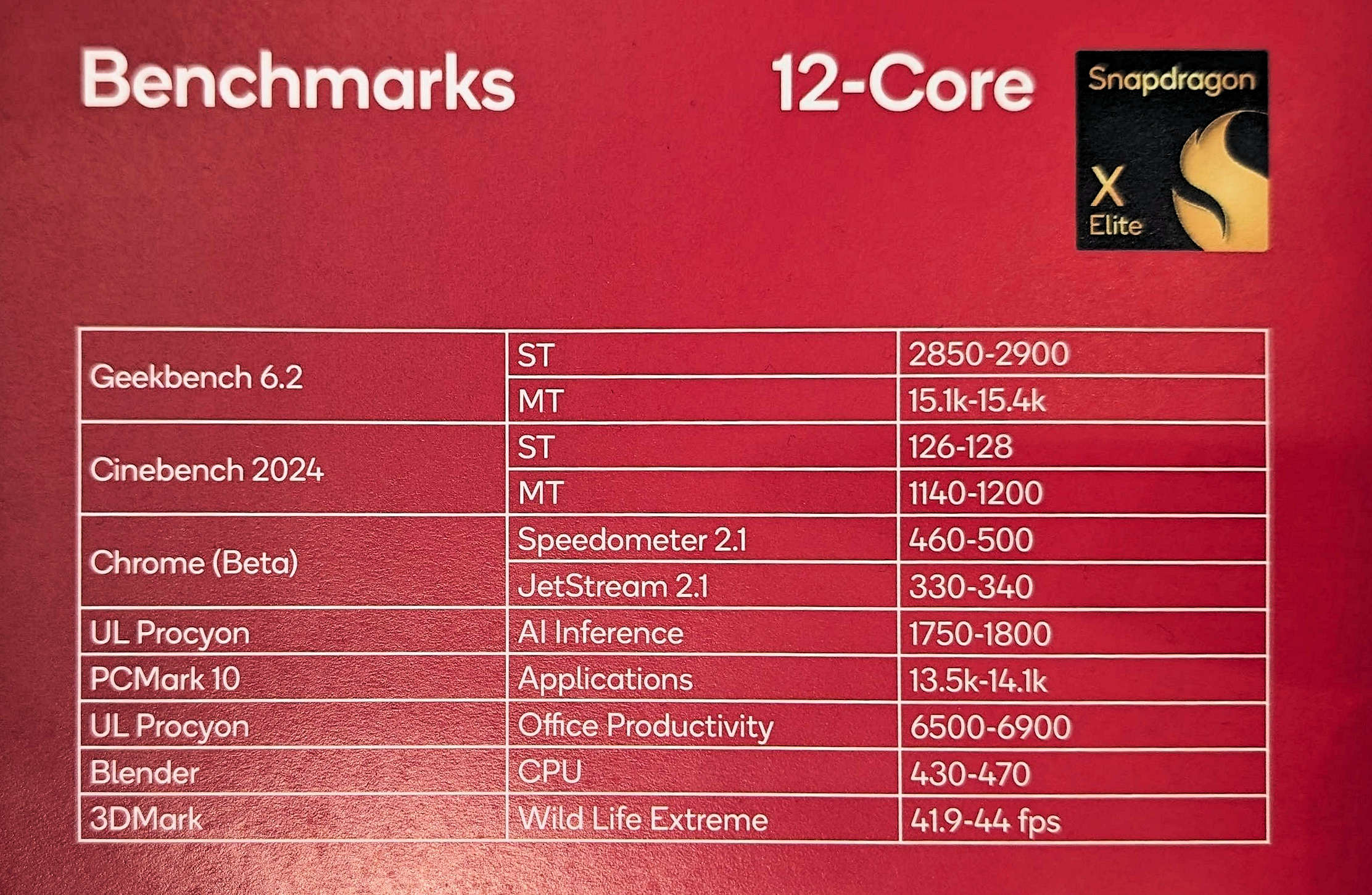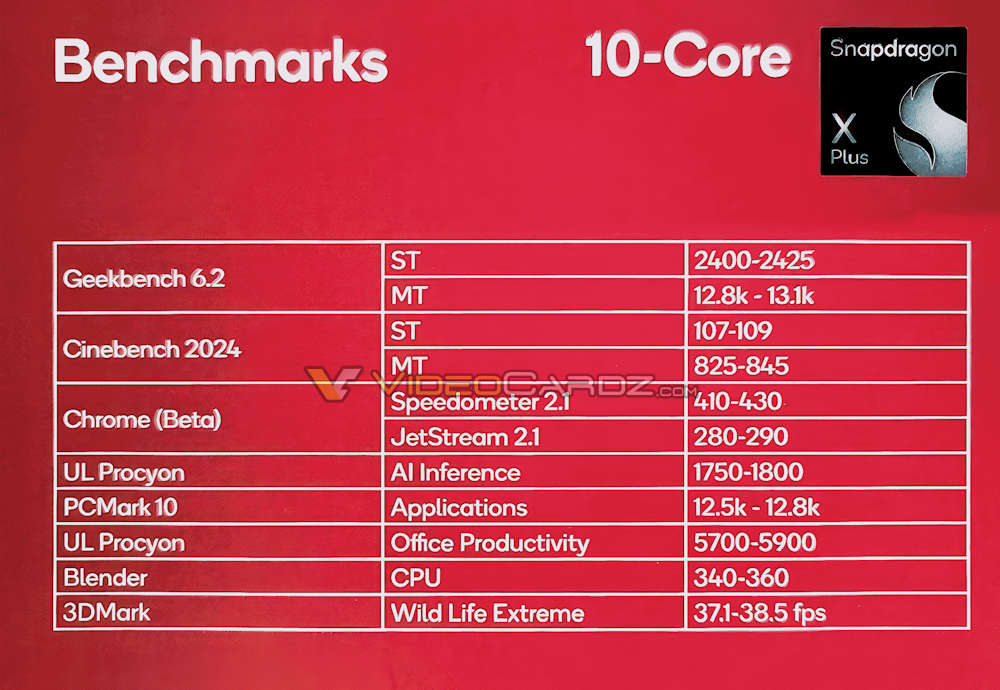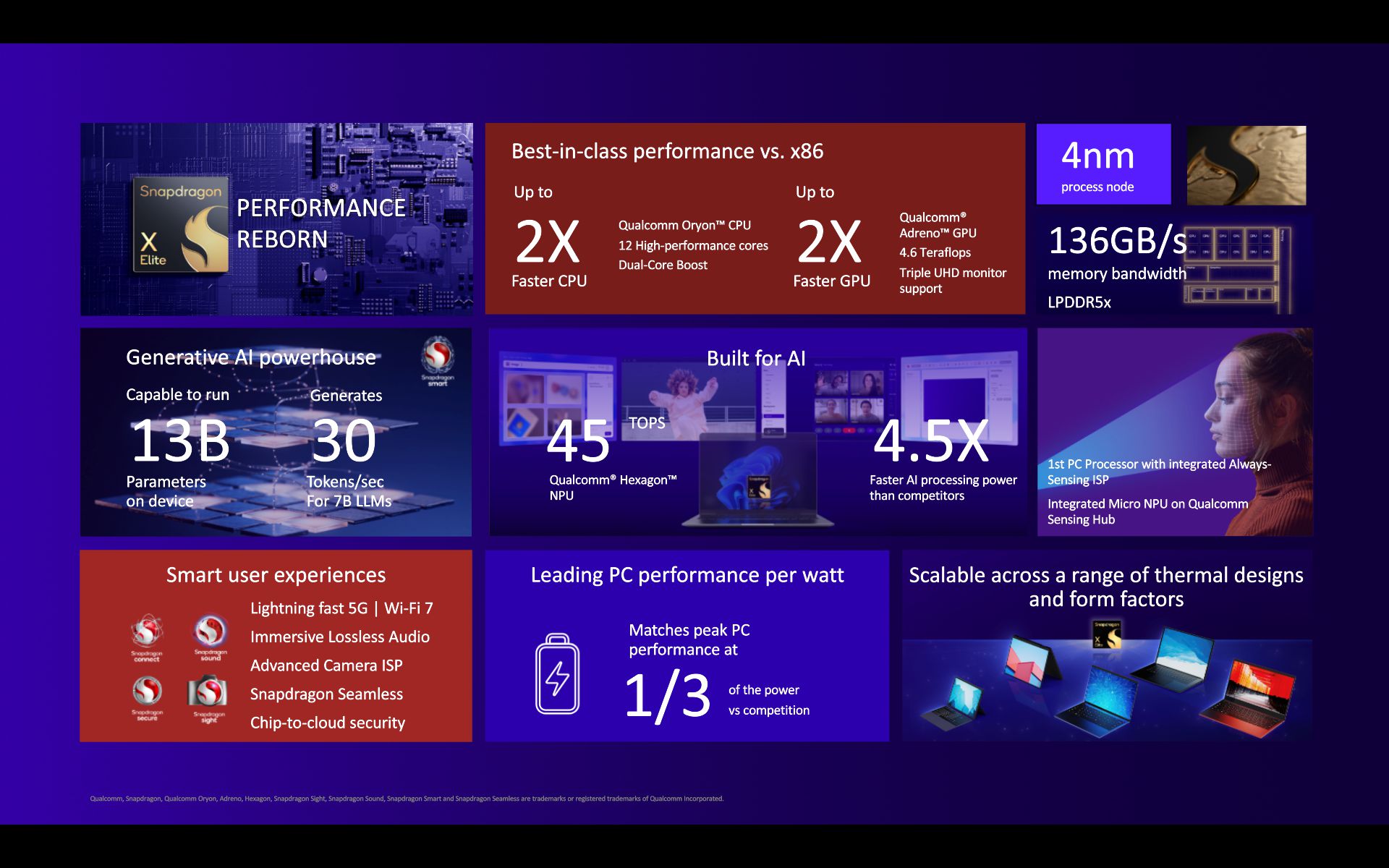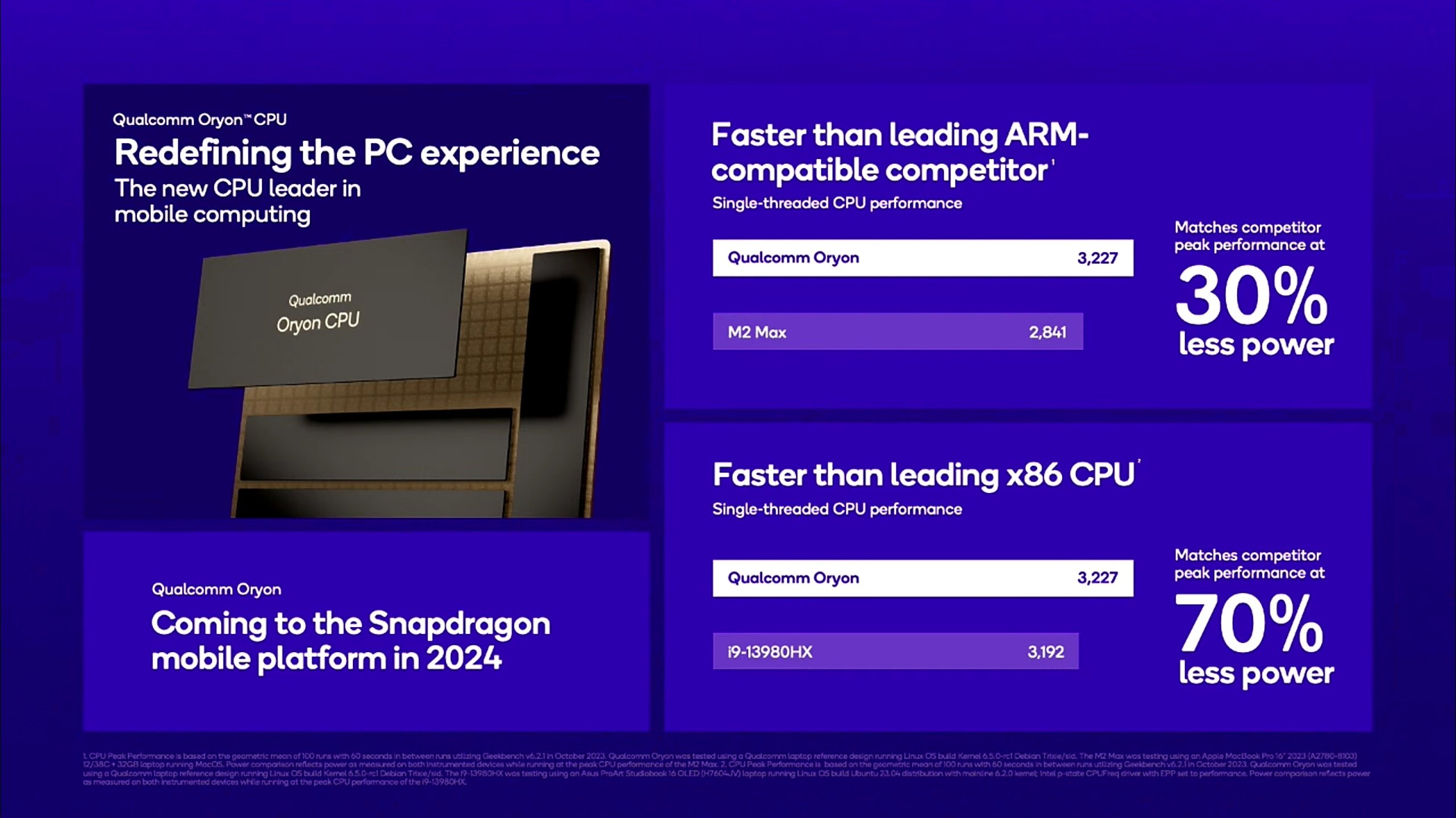You are using an out of date browser. It may not display this or other websites correctly.
You should upgrade or use an alternative browser.
You should upgrade or use an alternative browser.
Processador Arm for PC (Qualcomm 8cx 7nm)
- Autor do tópico Miguel_Pereira
- Data Início
Nemesis11
Power Member

3230 em Single Core no Geekbench 6???? Não pode ser. Deve-me estar a escapar algo nesse gráfico. No página de Top Scores do GeekBench 6, o processador com melhor resultado é o 13900KS com um score de 3100.
https://browser.geekbench.com/processor-benchmarks
Já agora, acho piada terem usado o Debian Sid para esse benchmark e não Windows.

Por um lado é bom saber que não deve ser complicado instalar Linux nele.

night_sign
Power Member
A Qualcomm está a fazer uns bons brinquedos.
Vamos ver se o M3 na próxima semana o vai passar em Single.
Vamos ver se o M3 na próxima semana o vai passar em Single.
LeonHeart
Power Member
Qualcomm Snapdragon X Elite Adreno GPU performance matches AMD Radeon 780M in gaming
Qualcomm’s first look at the Snapdragon X Elite PC processor
Will this architectural design be enough to rival upcoming PC systems in 2024, given the company’s provision of official Geekbench, Cinebench, and 3DMark benchmarks?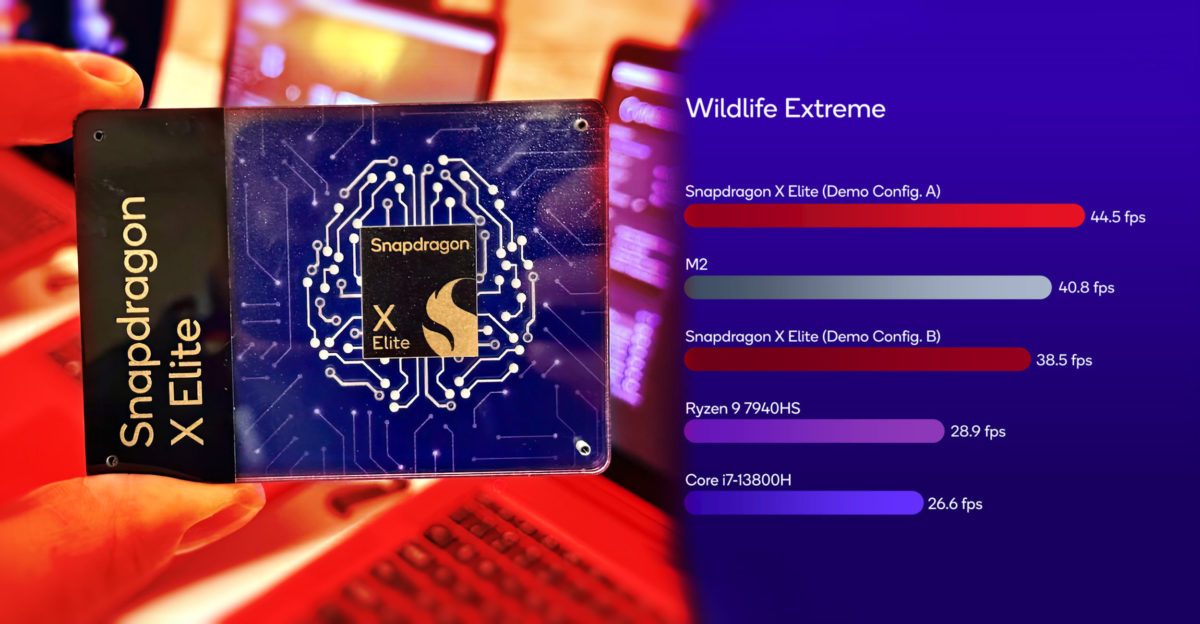
Snapdragon X Elite, Source: Qualcomm/ComputerBase
Qualcomm recently lifted the embargo on performance data shared with journalists last week, showcasing their new Snapdragon X Elite chip tailored for lightweight laptops. The company boldly compared their chip to leading industry counterparts, such as the AMD Ryzen 9 7940HS, Intel Core i9-13800H, and Apple M2. The competition appears intense, and Qualcomm’s performance metrics may suggest it stands alongside the prominent brands.
As Anandtech noted, “seeing is believing.” To substantiate their claims, Qualcomm organized live demonstrations during a closed-door event, providing journalists and analysts with an early glimpse of new reference systems. These demos included System A with a 15.6-inch 4K display and a chip TDP set at 80W, as well as System B with a smaller 14.5-inch screen boasting 2.8K resolution and a lowered TDP of 23W. While differences existed in screen resolution and battery size, they remained irrelevant to the CPU’s synthetic tests.
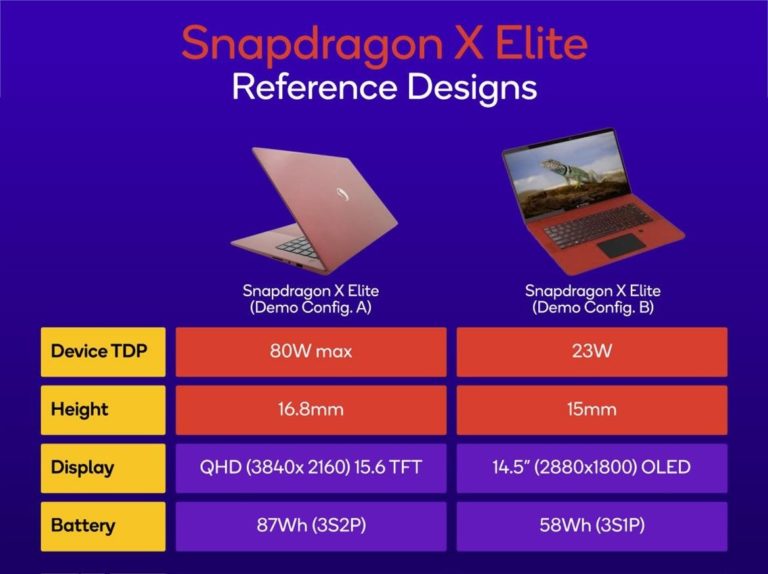
Snapdragon X Elite, Source: Qualcomm
The modification in TDP directly impacted the chip’s processing capabilities by fine-tuning the voltage frequency curve. This adjustment resulted in clock speeds of up to 3.8/4.3 GHz for the 80W system (for 2-core and all-core frequencies) and 3.4/4.0 GHz for the 23W system. It’s noteworthy that both systems utilized the same LPDDR5X-8533 memory.
For the GPU demo, rather than utilizing native Windows PC benchmarks to showcase Adreno’s GPU performance, the company opted for cross-platform and relatively dated tests, such as the Aztec Ruins benchmark. Notably, the 3DMark Wild Life Extreme, although not a high-end benchmark like 3DMark Speed Way, was chosen. This decision accommodates the inclusion of the Apple M2 benchmark, as the ARM architecture lacks Windows support.
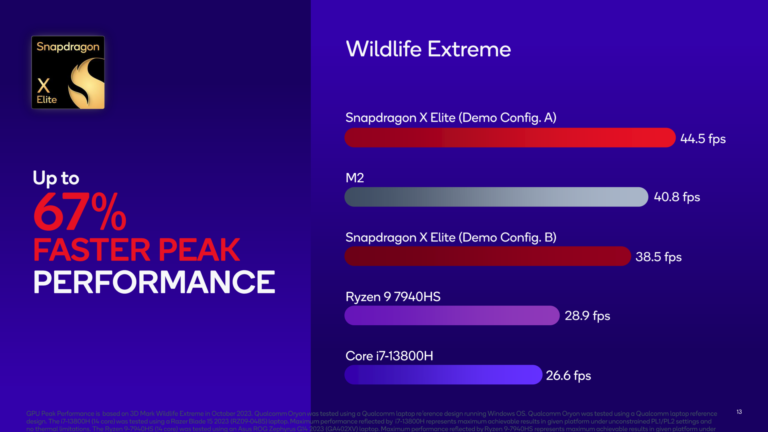
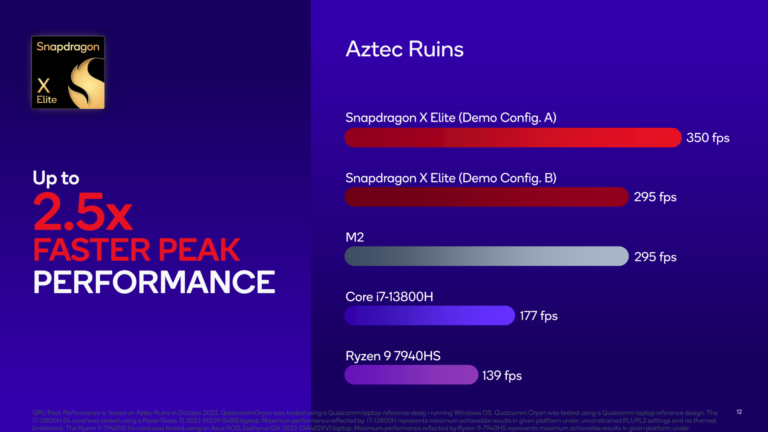
Snapdragon X Elite in GPU benchmarks, Source: Qualcomm
Qualcomm’s Adreno GPU consistently delivers better performance in 3DMark Wild Life Extreme and GFXBench Aztec Ruins (1080p, Normal) when compared to the integrated GPUs from AMD and Intel in the Ryzen 9 7940HS and Core i7-13800H. The presentation demonstrated that the Adreno GPU surpasses all three comparable systems in performance, with only the M.2 chip outperforming Demo Config B, although it still falls short of the 80W system’s performance. There doesn’t appear to be a substantial performance gap between the 80W and 23W systems.
While the performance figures do seem noteworthy for an integrated GPU, the more important aspect revolves around gaming capabilities. On the Geekerwan YouTube channel, they conducted tests on a system running two games. The second game, which didn’t fully utilize the GPU, indicating some driver-related issues, was omitted from the comparison. Thus, the chosen game for comparison is Control.
Unfortunately, it appears that ray tracing support is currently unavailable on the SD X Elite chip. The comparison involved running Control at a low preset with a 1080p and 1440p resolution, where the Qualcomm CPU achieved approximately 53 FPS and 32 FPS respectively. Under these settings, the processor’s performance is comparable to the AMD Radeon 780M RDNA3 graphics and surpasses the Intel Xe-LP graphics in the i7-13700H system. However, it falls short of the Apple M2 Max and any discrete RTX GPU, with the 3050 being at least twice as fast.
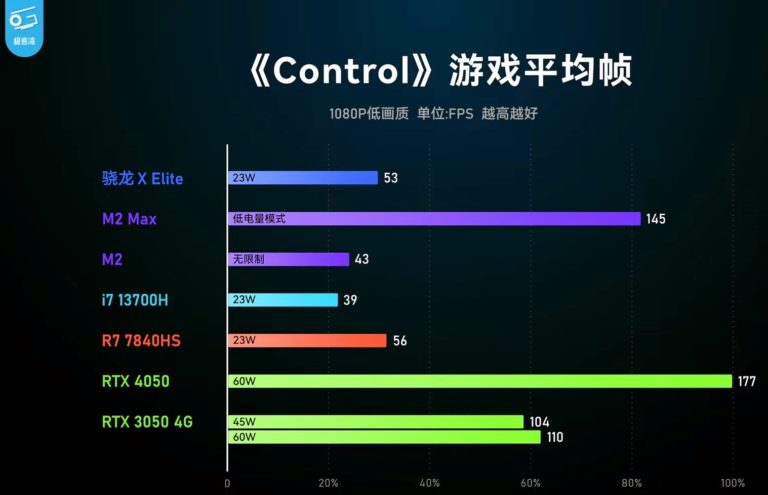

Snapdragon X Elite in Control, Source: Geekerwan
Qualcomm also provided some synthetic benchmarks for the CPU cores, but those are not as interesting to GPU fans.
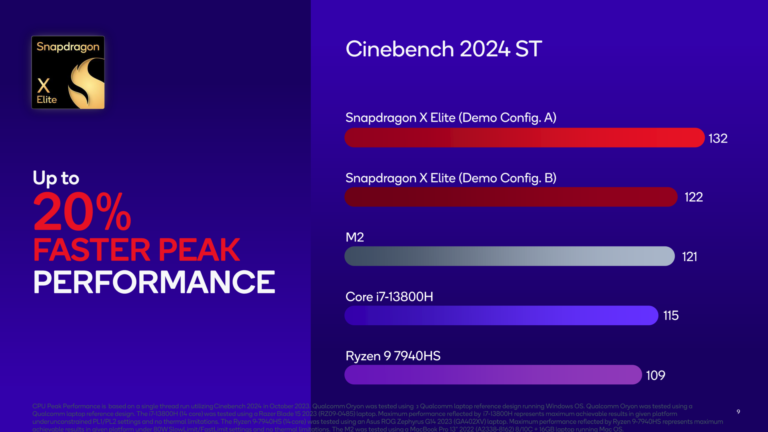
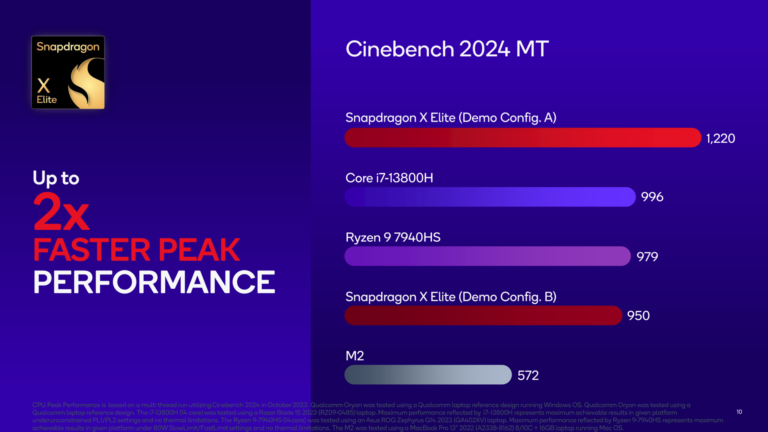
Snapdragon X Elite in Cinebench 2024, Source: Qualcomm

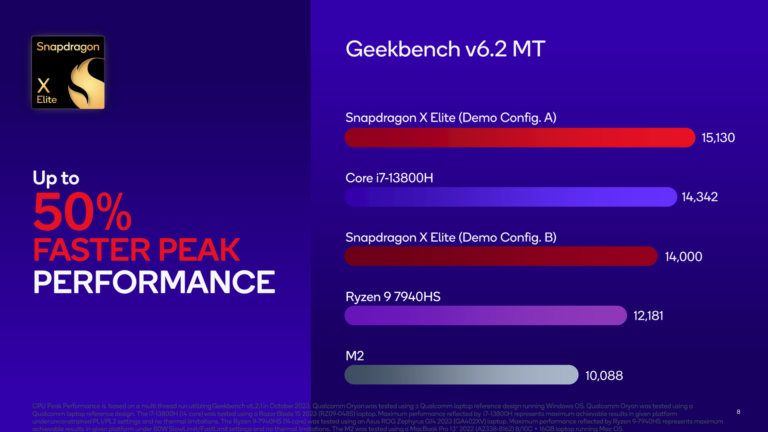
Snapdragon X Elite in Geekbench 6.2, Source: Qualcomm
These performance metrics provide only a glimpse of the platform’s capabilities. However, there is a significant drawback with the X Elite chip – it won’t be available for around six months. This extended timeframe allows all three major companies to make architectural updates.
AMD is set to introduce their Strix Point series, featuring the newer Zen5 CPU architecture, while Intel is just 1.5 months away from the Meteor Lake launch. Apple also has an upcoming event, possibly to unveil the M3 chip. Consequently, while Qualcomm’s X Elite chip may currently make a strong impression, the PC market will have evolved considerably by the time it becomes available.
Qualcomm claims its new chips are 21% faster than Apple’s M3
https://www.digitaltrends.com/computing/qualcomm-is-ready-to-compete-with-m3-series-in-2024/
https://www.digitaltrends.com/computing/qualcomm-is-ready-to-compete-with-m3-series-in-2024/
Qualcomm has compared the CPU to the new M3 chip, similarly claiming that its chip outperforms the leading ARM-compatible competitor for single-threaded CPU performance. Qualcomm also says the Oyron chip is 21% faster than the M3 in multi-core performance. That’s quite the bold claim.
Nemesis11
Power Member
Alegadamente, os Microsoft Surface 6 e Surface Pro 10, a serem anunciados em Março, parece que irão ter apenas versão ARM, com o Snapdragon X, pelo menos no mercado consumidor.
Late last year, I wrote about Microsoft’s plans for its upcoming Surface Pro 10 and Surface Laptop 6, which are expected to feature some major upgrades in the form of refreshed designs, new chips, and next-gen NPU silicon that will power some of the upcoming advanced AI features Microsoft is building into the next version of Windows.
I know that the June wave will include the Surface Pro 10 and Surface Laptop 6, as that’s when the first Qualcomm X Series PCs are expected to start shipping across the board. These PCs depend on the Windows Germanium platform release, which won’t RTM until April, making it too late for any PCs launching that month.
According to my sources, Microsoft intends to ship a commercial focused version of Surface Pro and Surface Laptop that feature the current in-market designs, but with newer Intel 14th-gen chips and a scoped set of features designed for commercial customers.
https://www.windowscentral.com/hard...face-pc-announcements-may-take-place-in-marchAs I understand it, consumers will be able to purchase these commercial focused devices if they wish, but the recommendation is to wait for the true Surface Pro 10 and Surface Laptop 6 coming in June with next-gen Arm chips and updated designs.
Microsoft is confident Windows on Arm could finally beat Apple
https://www.theverge.com/2024/4/8/2...k-air-surface-arm-qualcomm-snapdragon-x-eliteMicrosoft is so confident in these new Qualcomm chips that it’s planning a number of demos that will show how these processors will be faster than an M3 MacBook Air for CPU tasks, AI acceleration, and even app emulation. Microsoft claims, in internal documents seen by The Verge, that these new Windows AI PCs will have “faster app emulation than Rosetta 2” — the application compatibility layer that Apple uses on its Apple Silicon Macs to translate apps compiled for 64-bit Intel processors to Apple’s own processors.
Nemesis11
Power Member
Leak de um dos primeiros portáteis com este Snapdragon. Lenovo Yoga Slim 7 14 Snapdragon Edition.



Não há grandes detalhes. Apenas que tem um ecrã 14,5'' e é tão fino que só tem 3 portas USB-C e audio jack. Não tem altura para USB-A, HDMI, etc.
Gostava de perceber se o cooling é passivo.



Não há grandes detalhes. Apenas que tem um ecrã 14,5'' e é tão fino que só tem 3 portas USB-C e audio jack. Não tem altura para USB-A, HDMI, etc.
Gostava de perceber se o cooling é passivo.
Última edição:
Nemesis11
Power Member
Dia 24:
Leak do Thinkpad T14s Gen6 "Snapdragon Edition".



Leak do Thinkpad T14s Gen6 "Snapdragon Edition".



- 1x 3.5 mm jack
- 1x HDMI
- 1x Kensington Lock slot
- 2x USB Type-A
- 2x USB Type-C
LeonHeart
Power Member
Snapdragon X Elite and Plus specs leak ahead of official announcement
Qualcomm is getting ready to reveal the full specs of its upcoming Snapdragon X platform that will soon power next-generation Windows 11 AI PCs. The official announcement is expected on April 24, but someone has already leaked specifications of four different SKUs.It appears that the Snapdragon X platform will offer four different versions: three 12-core Elite variants with different clocks and GPU performance and one ten-core Plus configuration. The latter was earlier spotted in Geekbench powering the alleged Surface Pro 10.
| Core Count | Total Cache | Max Clocks | Dual-Core Boost | GPU | NPU | |
|---|---|---|---|---|---|---|
| Snapdragon X Elite X1E-84-100 | 12 | 42MB | 3.8GHz | 4.2GHz | 4.6TFLOPs | 45 TOPS |
| Snapdragon X Elite X1E-80-100 | 12 | 42MB | 3.4GHz | 4.0GHz | 3.8TFLOPs | 45 TOPS |
| Snapdragon X Elite X1E-78-100 | 12 | 42MB | 3.4GHz | - | 3.8TFLOPs | 45 TOPS |
| Snapdragon X Plus X1P-64-100 | 10 | 42MB | 3.4GHz | - | 3.8TFLOPs | 45 TOPS |

One of Qualcomm's engineers recently said that the platform should offer decent performance in games, and most titles should "just work." With the leaked details, we can see that the GPU performance is on par with Intel's latest Core Ultra processors and their 4.6TFLOPs of GPU horsepower. However, AMD's mobile Radeon 780M offers almost double the performance (via Videocardz).
According to leaked slides, Snapdragon X Elite and Plus chips should offer the following performance in various benchmarks:
| Snapdragon X Elite | Snapdragon X Plus | |
|---|---|---|
| Geekbench 6.2 | 2850-2900 single-core 15,100-15,400 multi-core | 2,400-2,425 single-core 12,800-13,100 multi-core |
| Cinebench 2024 | 126-128 single-core 1,140-1,200 multi-core | 107-109 single-core 825-845 multi-core |
| Chrome (Beta) - Speedomter 2.1 | 460-500 | 410-430 |
| Chrome (Beta) - Jetstream 2.1 | 330-340 | 280-290 |
| UL Procyon AI | 1,750-1,800 | 1,750-1,800 |
| UL Procyon Office | 6,500-6,900 | 5,700-5,900 |
| PCMark 10 | 13,500-14,100 | 12,500-12,800 |
| Blender | 430-470 | 340-360 |
| 3DMark | 41.9-44FPS | 37.1-38.5FPS |
First Windows 11 PCs with Snapdragon X processors inside are expected to hit store shelves in the next couple of months. If recent leaks and code discoveries are to be believed, those ARM PCs will have a minimum of 16GB of memory.

